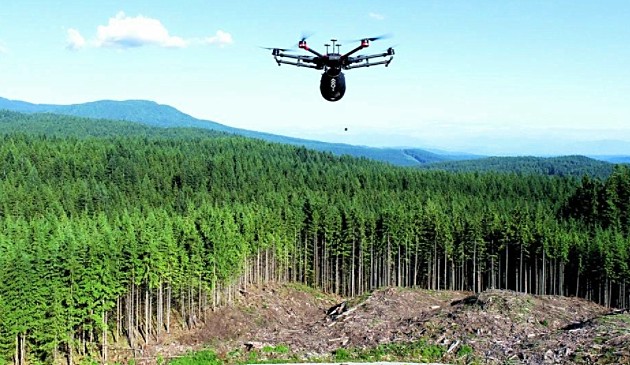A Canadian company, Flash Forest, is using aerial drones, mapping software, automation, and biological seed pods to do rapid reforestation. The goal is to plant a billion trees by 2028, dropping from 40,000 to 100,000 seed pods daily.
Canada’s current Liberal government pledged three years ago to plant 2 billion trees by 2030. In the years that have followed the government hasn’t kept up a pace in planting seedlings that will get it close to that 2030 goal. But Flash Forest, a Canadian startup, may make the government’s plan succeed.
Seen below, Flash Forest seed pods bear a remarkable resemblance to blueberries. Inside each is a future pine or spruce tree common to the habitat where the pods will be released. The idea of using aerial drones to disperse seeds is not new. Myanmar is using them to repopulate mangrove forests to supplement over 2.7 million hand-planted trees in an attempt to restore shoreline ecosystems, reduce erosion, and mitigate sea-level rise.

In the United Kingdom, a British company, Dendra, has plans for aerial drones to plant 500 billion trees between now and 2060. Aerial mapping supplemented by artificial intelligence software helps in site selection for its seed dispersal.
Another UK company, BioCarbon Engineering, is also using aerial drones this way. But it operates up to six drones with a human pilot controller. It claims it can plant up to 100,000 seeds per day.
Why have these companies chosen aerial drones to do the work usually done by forest crews equipped with a bag of seeds and a shovel? Because drones are faster and more capable of dispersing seeds. They make up in volume for the fact that they are not on the ground putting a shovel and earth to every seed or seedling put in the ground. And aerial reseeding using helicopters which is being done in some countries is proving to be less effective as well because drones are more maneuverable and capable of hitting selected targets more effectively.
In its many climate change reports, The Intergovernmental Panel on Climate Change talks about the need to do reforestation as a natural mitigation process to fight global warming. It states that an area the size of the 48 contiguous US states if planted with new forests, would be enough to draw down carbon dioxide (CO2) from the atmosphere to keep temperatures from rising beyond 1.5 Celsius (2.7 Fahrenheit) degrees.
Angelique Ahlstrom, Co-founder and Chief Strategy Officer at Flash Forest, told Adele Peters of Fast Company, that many different reforestation projects are on the go today but results so far are not promising with net losses of 7 billion trees annually.
Each Flash Forest seed pod includes enough water and a proprietary mix of ingredients to protect the seed even during prolonged periods of drought. The firing mechanism uses pneumatics to ensure the seed pods hit their targets with enough force to push them well below the soil surface.
Post planting, Flash Forest uses its aerial drones to survey the progress of the planting and to measure the rate of carbon sequestration as the trees grow. Although a good percentage of the seed pods are expected to fail, the volume of planting ensures a significant natural survival rate.
It should be noted that seedlings don’t sequester a lot of CO2. Mature trees do. So planting a billion trees that Flash Forest has set as its goal by 2028 will not create an immediate and significant carbon sink. But by 2050 when Canada has set its goal to be net-zero, the work of these aerial drones in the present should contribute to the global warming mitigation effort.
















